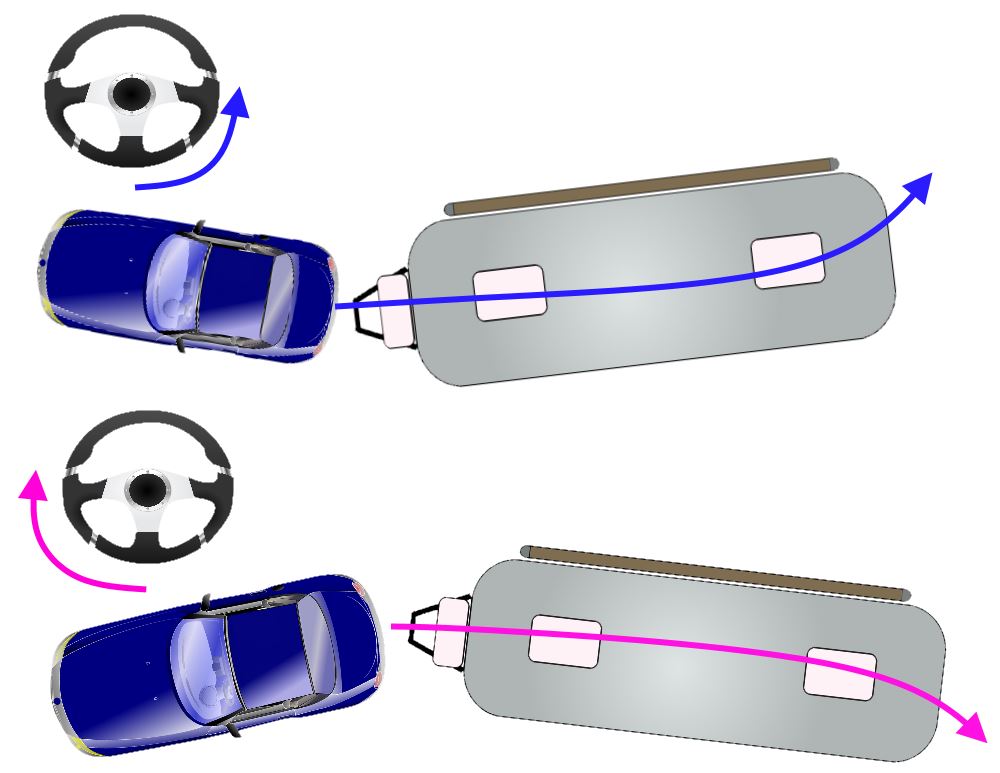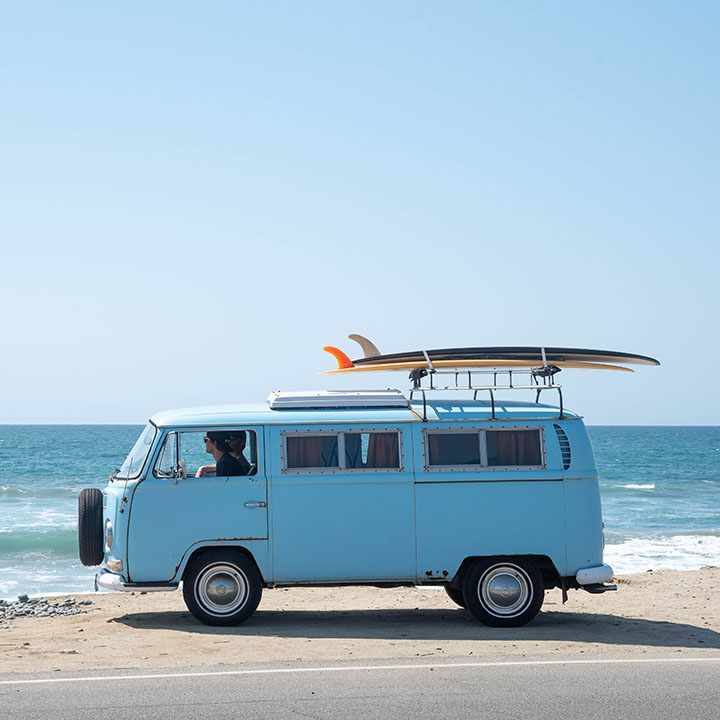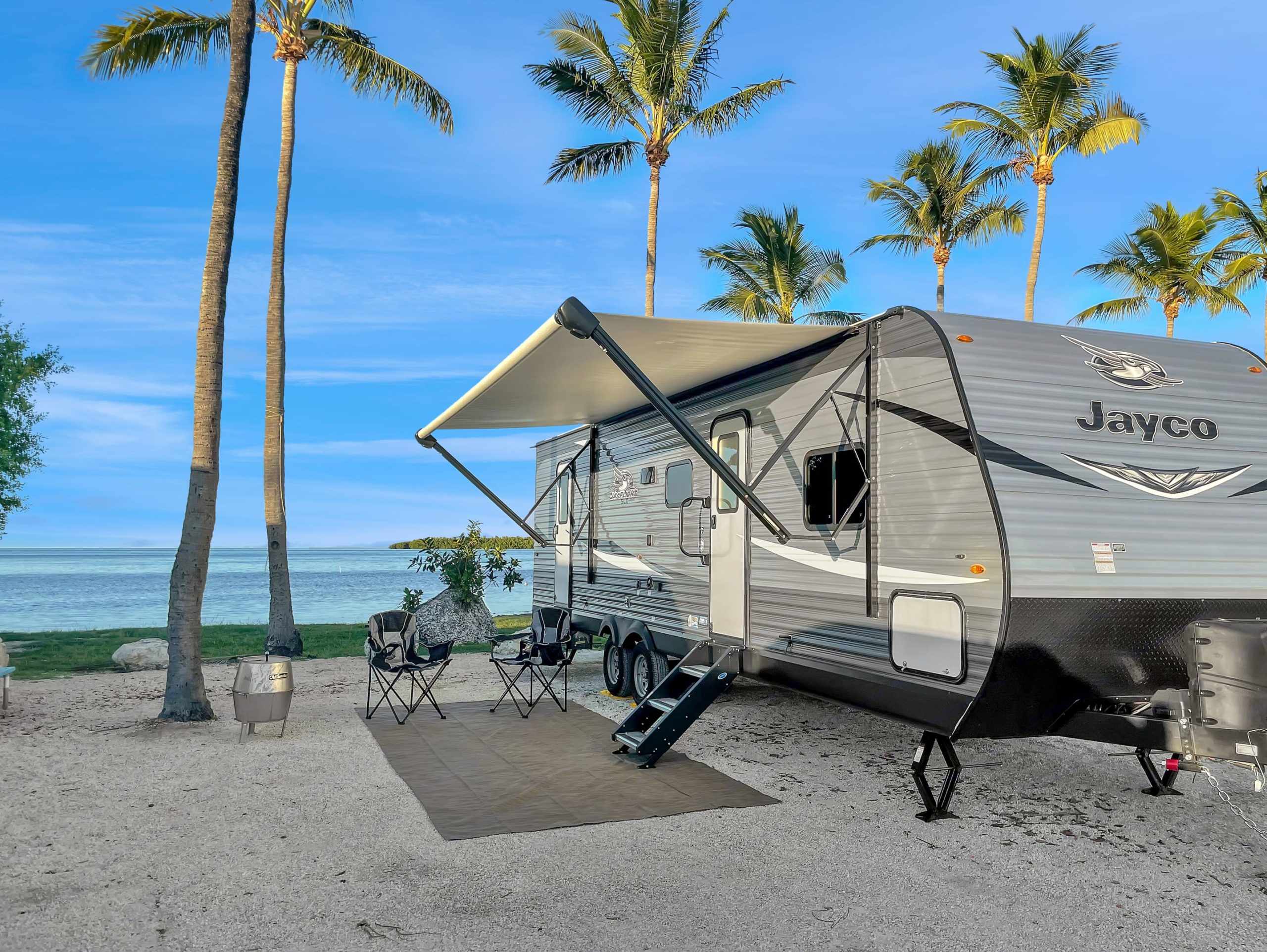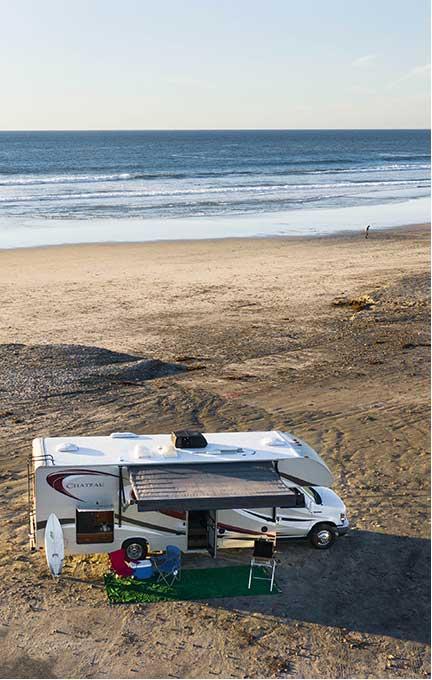Towing a travel trailer is generally pretty easy if you know what to expect. This article will cover the basics you need to know and help you be ready for your first towing experience. It can be scary at first. But before long, you will feel comfortable and confident behind the wheel.
And be sure to check out this guided search on our site to find the right RV for you.
We’ll cover three main tips in this article:
- Prepare properly: Before leaving, make sure you hitch your vehicle correctly, check your visibility, and check your brakes and brake controller.
- Be in the know: Make sure you know your trailer height and route details.
- Drive safe: Be cautious when turning and backing up. Understand how towing a trailer affects going up and down hills and how your truck brakes. Always be on the lookout for trailer sway and remember to take it easy!
This article will go over each of these areas in more depth, so buckle up!
Travel Trailers For Rent Near You
Travel Trailer Towing Tip #1: Prepare Properly
Many of the most important things you can do to ensure a good trip happen before you start driving. This will both give you peace of mind, and ensure that you encounter as few challenges as possible.
Hitch Your Vehicle Correctly
To drive safely, you need to be hitched safely. You can check out our guide to safely hitching and unhitching for all the details on getting a safe and secure connection. The basics are to make sure your hitch is on, locked in, and your cables are connected and working properly. If you need a refresher, check out this basic explainer video from FraserwayRV.
You also want to pay attention to the weight distribution. Looking at your tow vehicle and trailer, you want to observe a nice flat plane between the two. If there is tipping towards the hitch, or tipping away from it, they are not well balanced.
An imbalance can cause your trailer to be more vulnerable to sway, which we will talk about more in the driving section of this guide. The most accurate way to check weight distribution is to go to a truck scale and have them measure the weight on all your tires. Still, if you are parked on a flat surface, then you can generally get a good feel for it just by eyeballing it.
Check Your Visibility
Unless you have a rearview camera for your trailer, your rearview will be limited to the side mirrors on your tow vehicle. Make sure you can see the rear end of your trailer through both side mirrors.
If your visibility feels too limited, you can buy side mirror extensions meant for towing that will give you a wide-angle view as well as your normal mirror view.
Shop side mirror extensions on Amazon.
Check Your Brakes and Brake Controller
Before you get out on the road, you want to make sure your brake controller is properly configured. The brake controller is what turns on the trailer brakes when you activate the tow vehicle brakes. It has a setting that controls how hard it applies the trailer brakes. To test it, get up to about 10 mph and then apply the brakes as you would for a normal stop.
You should feel like the trailer is tugging back on the vehicle just a tiny bit, especially as you come to a full stop. If you don’t feel the trailer tug, or worse, you feel it pushing you, then you need to turn the brake controller setting higher. If your stop is super jerky, then you need to turn it down.
What you are shooting for is to have the trailer braking just a tiny bit more than the tow vehicle. This keeps the trailer from pushing forward on the tow vehicle during braking, which could cause you to jackknife. It also ensures the fastest and smoothest stopping.
Go Over Your Towing Safety Checklist
Before every single trip, go over your safety checklist, making sure everything looks right before you ever hop in the driver’s seat.
- Inspect the Hitch: Double check your hitching job. Ensure the hitch is securely attached and rated for your trailer’s weight.
- Brake Lights and Signals: Test all lights, including brake lights and turn signals, for proper functionality.
- Tire Condition: Inspect tires for proper inflation, tread wear, and overall condition on both the vehicle and trailer.
- Safety Chains: Attach safety chains securely in a crisscross pattern.
- Load Securely: Ensure all cargo in the trailer is well-secured to prevent shifting.
- Breakaway Switch: Check that the breakaway switch is functioning properly.
- Emergency Kit: Carry an emergency kit with essentials like flares, a first aid kit, and basic tools.
By following this checklist, you can enhance your safety while towing a travel trailer.
Travel Trailer Towing Tip #2: Be in the Know
It’s important to get everything hitched up correctly, but it’s also important to do a little trip planning beforehand.

Know Your Height
It is crucial to know how tall your trailer is. The last thing you want to do is destroy it by trying to drive under a bridge that is too low. Find out your height, add a foot just to be sure, and avoid any passage marked with a lower clearance than that value.
Know Your Route
You don’t want to be confused over where you are going while driving a trailer. Your ability to maneuver in traffic or make course corrections is considerably more limited, especially on narrow roads or in urban areas.
I highly recommend having a navigation system that includes a trailer or RV setting. This will do a few things for you. It will steer you clear of low bridges and the like. It will also keep you off of narrow one-way roads. Finally, it will let you know the proper speed for a vehicle of your type. Of course, it also helps you plot a good course for your destination.
Know the Laws
Towing laws can vary significantly across states, affecting vehicle requirements, trailer size limits, and safety regulations. Here are some key considerations:
- Towing Capacity: Each state may have specific regulations regarding the maximum towing capacity of vehicles, which can influence your choice of tow vehicle and trailer.
- Weight Limits: Many states impose weight limits for trailers, including gross vehicle weight ratings (GVWR) that should not be exceeded.
- Brake Requirements: Some states require trailers over a certain weight to have their own braking system.
- Equipment Requirements: States often have unique requirements for safety chains, brake lights, and reflectors.
- Speed Limits: In some states, the speed limit is different for those towing trailers than for regular passenger vehicles. Pay attention to speed limit signs to ensure you know the limit that applies to you.
Always check local regulations before towing to ensure compliance and safety. For detailed state-by-state towing laws, visit your state’s Department of Motor Vehicles (DMV) website or consult a local towing resource.
Travel Trailer Towing Tip #3: Drive Safe
It’s actually pretty easy to drive a travel trailer. As you drive forward, the trailer will follow you in a very natural way. Provided your vehicle is rated to tow your trailer, you will not find it hard to go up hills, brake, or do most of the other things you would normally do while driving. That said, it isn’t without any special challenges or dangers. Let’s look at some of the potentially tricky parts.
Turning
This is easier than you might think. The trailer will naturally follow the path of your tow vehicle when moving forward. The only rule of thumb is that the longer your trailer is, the wider you want to turn. A long trailer can end up cutting a corner that was close to the vehicle. Just keep your turn as wide as the roadway reasonably permits, and you should be fine with nearly any right-angle turns. Curves and roundabouts are generally no sweat in a trailer.
Any turn sharper than 90 degrees can be an issue. You want to avoid those whenever you can, and if you can’t, take them as wide as possible. Trying to do a shimmy where you back up to get more turning room won’t generally work in a trailer. Backing up a trailer is a tricky business.
Finally, don’t take turns too fast. Trailers have a higher center of gravity than most vehicles. That means a turn that might be safe for a car, could tip a trailer over. Take it slow and steady and obey the recommended speed limits.
Backing Up
This is actually pretty challenging. And the bigger the trailer, the more tricky it becomes. You should practice when there is nothing to run into before you try it for real. The way a trailer backs up is not intuitive and simply takes getting used to before it feels natural. Take it slow and steady, and you should be fine. We have a whole article on pro tips for backing up a trailer complete with diagrams, techniques, and advice. I highly recommend giving it a read.
My biggest tip for you here is to avoid situations where you need to back up under any kind of pressure. Thus, avoid doing it on the roadways, if at all possible. Stress and pressure will only make it harder and increase the chance of making a costly error.

Hills
Steep hills and mountain passes can be a challenge for some trailers. If you are pushing the boundaries of your tow rating, they can be a bit stressful. Nonetheless, it’s usually not a real problem, so long as you know what to do. The main thing is to keep to the right if you are going to be slow going up the hill. If you are well below the speed limit, I’d suggest turning your hazard lights on to let other drivers know.
Coming down a hill is a bit more dangerous. But again, if you play it safe, there should be no problems. If your tow vehicle is capable of engine braking, this is a good practice. Engine braking is when you put your engine into a lower gear as you go down a hill and take your foot off the accelerator. The drivetrain will run the engine and the mechanical resistance slows your roll down the hill. It’s a good way to control your speed, and it eases up the wear on your brakes.
You may still need to apply your brakes as well, especially on a very steep grade. One thing you want to avoid is braking too hard while you are in a turn and going downhill. This can cause the trailer to jackknife and lead to an accident. Try to make sure you are at a slow enough speed going into the turn and then maintain that speed or gently decelerate. Keeping a nice, steady, controlled speed is the key to safety in this situation.
Braking
The main thing to keep in mind here is, that with a trailer, your stopping distance is longer. You want to maintain a good distance between you and the vehicle in front of you so that you have plenty of time to stop. Give yourself more room than you would normally allow and don’t trust the intuition you developed driving a smaller and lighter vehicle.
Trailer Sway
Trailer sway is one of the special dangers of towing a travel trailer. The phenomenon is best described as the trailer and tow vehicle wiggling back and forth. What happens is that something pushes on the trailer, and it, in turn, pushes on the tow vehicle. The back-and-forth reaction makes the sway action grow stronger until it causes a catastrophic crash.
The best thing you can do to deal with sway is to avoid it happening in the first place. A good set of sway arms on your hitch helps too.
Step one is to make sure you have good weight distribution on your trailer. Bad weight distribution lowers traction and amplifies the swaying. The second is not to drive in high winds. Because your trailer is bigger than your tow vehicle, the wind pushes unevenly on them. That makes the trailer move more and starts the sway. The bigger your trailer, the more sensitive it is to the wind. Finally, don’t drive too fast. The faster you go, the more dramatic the sway, and the harder it is to get under control.
The cause of sway that is hardest to avoid is people passing your trailer at a much higher speed. A big semi zooming past you will hit you with a wake of air that can set the sway in motion and take you by surprise.
If you do start to feel a sway, do not try and correct the sway by counter-steering. This actually enhances the swaying. You want to stay calm and get back to going in a straight line. Here is how you can stop sway:
Stopping Sway
The best thing to do is to use the manual trailer brake on your brake controller. This causes the trailer to engage its brakes, pulling back on the tow vehicle, forcing them into a straight line. You should practice this kind of braking in a parking lot or the like, so you can execute it calmly and know what it feels like. It can be a bit jarring. If you have your brake controller such that it applies the trailer brakes a bit stronger than the tow vehicle brakes – something I recommend- then for minor sway, you can use the regular brakes with some success. I generally do that first, but if it fails, I quickly hit that manual brake.
If braking would be dangerous, say because there is someone right behind you driving too close, your other option is to temporarily hit the gas while steering straight ahead. This causes the tow vehicle to pull harder on the trailer, yanking it straight. The problem with this second technique is that the faster you go, the stronger the swaying forces can become, so you might just make the situation worse. Still, keep that as an option in your toolkit of reactions.

Keeping Right
In nearly every state, slower-moving and larger vehicles are required to keep to the right lanes of the highway whenever possible. It’s better for the overall flow of traffic, and it is generally safer. The one challenge this can present is when there are many on and off-ramps on the right lane. A trailer, due to its size, can be harder to merge with other traffic.
Many drivers don’t get that your acceleration and deceleration are more limited. If I am in a really dense part of the highway, I’ll take the next lane to the left to try and ease up on the constant merging. Provided there are at least two lanes to my left, I feel this is a reasonable compromise in this particular situation.
When picking a lane, you can observe what commercial truck drivers are doing and follow their lead. They drive the same roads constantly and tend to know which lanes provide the smoothest travel while still obeying the legal requirements. Not every trucker sets a good example, but they are often the most experienced highway drivers on the road.
Take It Easy
I’d tell this to nearly any driver, but with towing a trailer it is especially true. It’s much more important to arrive in one piece than it is to arrive in time. Every trailer has a speed at which it becomes unsafe. Excessive speed can easily cause trailer sway, and it makes any situation that comes up harder to react to. You are not in a race, and there is no prize for getting somewhere the fastest. Stay safe and drive at a speed where your trailer is safe to maneuver.
If you feel you are too slow and are blocking other drivers, the correct response is not to go faster than you feel safe, but to find a place to pull over and let the other drivers pass. If you have a big train behind you, this is often a legal requirement. The rule of thumb is that five cars on your tail is enough to pull over for.
When you do need to change lanes or make a turn, be sure to give other drivers sufficient time to react by using your turn signals early and often. Try to be patient and give folks the time needed to make space for where you need to go.
Travel Trailer Towing FAQ
What is the best vehicle for towing a travel trailer?
The best vehicle for towing depends on your trailer’s weight and size. Typically, full-size trucks and SUVs with strong engines and high towing capacities are ideal. Be sure to check the vehicle’s towing capacity in the owner’s manual and compare it to your trailer’s weight.
How do I determine my trailer’s weight?
To determine your trailer’s weight, check the manufacturer’s specifications for the dry weight. Additionally, consider the weight of any cargo, water, and propane that will be loaded in the trailer, which can significantly increase the total weight.
What safety equipment is necessary when towing?
Essential safety equipment includes a properly rated hitch that matches the trailer’s weight, safety chains for backup, functioning brake lights, and a breakaway switch that activates the trailer’s brakes if it becomes detached from the towing vehicle.
Can I tow a trailer with a car?
Yes, but ensure your car is rated for towing and check the trailer’s weight. Small travel trailers and pop-ups can often be towed by larger sedans or SUVs, but always consult your vehicle’s owner’s manual for guidance.
Congrats, you now have the knowledge you need to tow a travel trailer with ease. And there are plenty of travel trailers to rent in your area!








